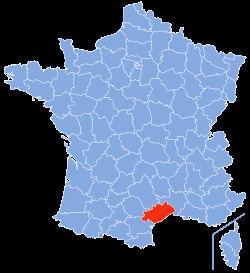Country France Subprefectures BéziersLodève Department number 34 Area 6,101 km² Population 1.092 million (2013) | Region Occitanie Time zone CET (UTC+1) Arrondissements 3 | |
 | ||
Colleges and Universities Paul Valéry University, Montpellier III Points of interest Cirque de Navacelles, Grotte des Demoiselles, Cap d'Agde, Musée Fabre, Pic Saint‑Loup Destinations | ||
Hérault ([eʁo]; Occitan: Erau [eˈɾaw]) is a department in southern France named after the Hérault river. It is part of the Occitanie region of the country.
Contents
Map of H%C3%A9rault, France
History
Hérault is one of the original 83 departments created during the French Revolution on 4 March 1790. It was created from part of the former province of Languedoc.
At the beginning of the 20th century, viticulture in the region was devastated by a slump in sales combined with disease affecting the vines, and thousands of small scale producers revolted. This revolt was suppressed very harshly by the government of Georges Clemenceau.
The catastrophic frost of the winter of 1956 damaged the olive trees, and the olive-growing regions did not recover until the late 1980s. Many of the olive-industry co-ops closed.
During the second half of the twentieth century the Montpellier basin saw some of the most rapid population growth in France.
Geography
Hérault is part of the current region of Occitanie and is surrounded by the departments of Aude, Tarn, Aveyron, Gard, and the Mediterranean (Gulf of Lion) on the south. The department is very geographically diverse, with beaches in the south, the Cévennes mountains in the north, and agricultural land in between.
The important rivers are:
The area of Hérault near the town of Lodève is an antipode point with Chatham Island, off the east coast of New Zealand.
Climate
The average daytime temperature is around 25-30 degrees Celsius in July and August and 8-10 degrees Celsius in December and January.
Politics
The President of the General Council is André Vézinhet of the Socialist Party.
Demographics
The inhabitants of the department are called Héraultais.
Culture
Montpellier hosts the following festivals:
The Canal du Midi has been designated as a World Heritage Site by UNESCO.
Tourism
The Mediterranean beaches are a major attraction, as well as the caves of Clamouse and Demoiselles.
Pézenas, former Royal city, has one of the oldest French "secteur sauvegardé", meaning an urban protected area. More than 30 mansions, with stone stairs, courtyards, decorated facades are located in a small perimeter (17 ha).
Part of Cap d'Agde is a major nudist resort.
Cruising along the Canal du Midi and walking or cycling along the tow paths is a popular holiday option.
